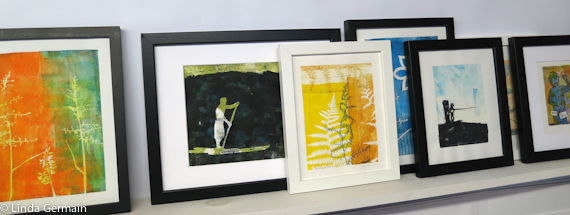
I often forget that the average person does not know what an original print is. I was reminded of this at the crafter’s fair at the River Ruckus in Haverhill this past weekend.
I try to use familiar words and concepts to describe the monotype process, but I often lose them in the first few sentences. I should have had my video with me, or maybe some process pictures. I found a fun and interactive slideshow from the folks a MOMA. It explains what a print is and gives great examples.
Sometimes the mystery of printing on Jello, holds the viewer’s interest for a while. It is such a user friendly process – I need to find the words to create a bridge to understanding printmaking and monotype printing.
A gelatin monotype print is a one of a kind original print. It is created by making marks in a thin layer of ink on the surface of a plate of gelatin. Gelatin is soft and malleable and can hold delicate details. These details are transferred to paper by hand pressure alone. This is the beauty of gelatin printmaking, the transfer of delicate details by hand pressure alone. It is a water based non-toxic process that is experimental and user friendly. I think it is easier to watch the video.
Or join me for a day of gelatin play – check out the dates here.
Happy Printing!
Great slide presentation from MOMA. I too have trouble explaining gelatin printing to people. It is very confusing. First of all they think it is the gelatin process used in photography with all the chemicals.
I have given up and just call them monoprints. It is easier than explaining the gelatin part. Also, some artists have a bit of an attitude about it as well. When I took my monoprinting class last spring, the teacher wanted nothing to do with my gelatin prints……..it was weird.
By the way, what size is your cookie sheet that you use? I have a few different sizes but I wanted to try your recipe and have it fit correctly,
Hey Roberta,
I have been using the cookie sheet from the dollar tree.It is 9″ x 13″. I put about 4 cups of fluid gelatin in there. It is not an exact science by any means. If you use 2 heaping tablespoons to every cup of water you should be fine. Make sure you are on a level surface!! and watch as you pour so gelatin does not dribble in unwanted places.
Good luck,
Linda